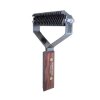Caiti
Experienced Member
I have never owned a longer haired dog, like an Aussie, and I'm a bit confused on the exact grooming requirements of them. I understand that I will have to brush Matrix frequently, but what exactly do you guys do to manage your Aussie's coat and keep it in condition?
Also, my mum spent a few months working in Petsmart and has cone out obsessing with the Furminator DeShedding brushes. I'm pretty sure that she is going to make it mandatory that I get one for Matrix. Does anyone have experience with those?
Also, my mum spent a few months working in Petsmart and has cone out obsessing with the Furminator DeShedding brushes. I'm pretty sure that she is going to make it mandatory that I get one for Matrix. Does anyone have experience with those?






 .
.